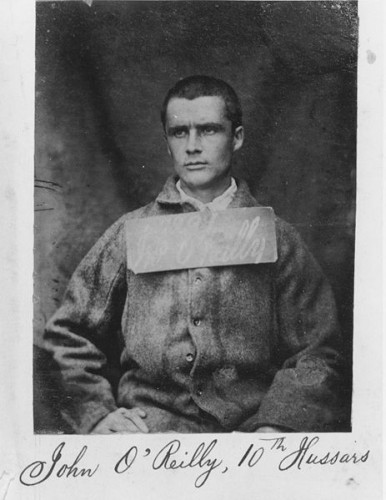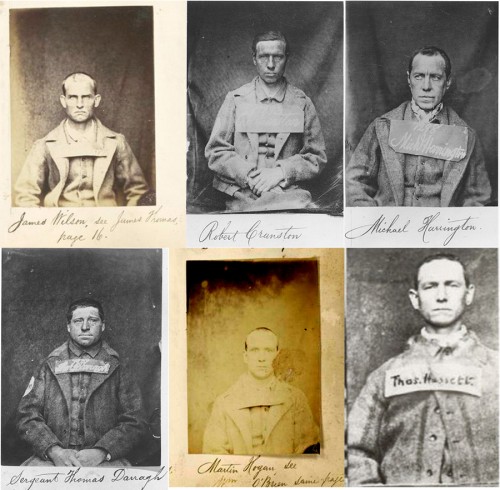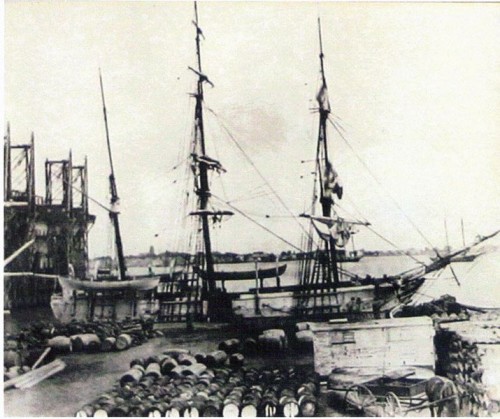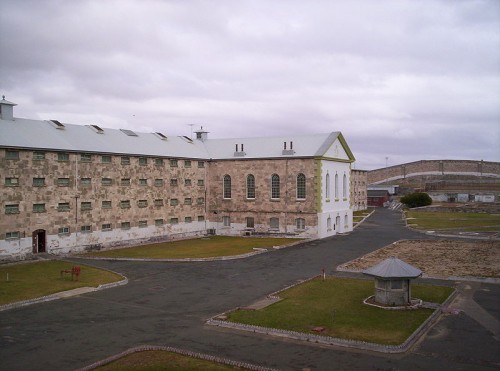The Most Audacious Australian Prison Break of 1876
An American whaling ship brought together an oddball crew with a dangerous mission: freeing six Irishmen from a jail in western Australia
![]()
The plot they hatched was as audacious as it was impossible—a 19th-century raid as elaborate and preposterous as any Ocean’s Eleven script. It was driven by two men—a guilt-ridden Irish Catholic nationalist, who’d been convicted and jailed for treason in England before being exiled to America, and a Yankee whaling captain—a Protestant from New Bedford, Massachusetts—with no attachment to the former’s cause, but a firm belief that it was “the right thing to do.” Along with a third man—an Irish secret agent posing as an American millionaire—they devised a plan to sail halfway around the world to Fremantle, Australia, with a heavily armed crew to rescue a half-dozen condemned Irishmen from one of the most remote and impregnable prison fortresses ever built.
To succeed, the plan required precision timing, a months-long con and more than a little luck of the Irish. The slightest slip-up, they knew, could be catastrophic for all involved. By the time the Fremantle Six sailed into New York Harbor in August, 1876, more than a year had passed since the plot had been put into action. Their mythic escape resonated around the world and emboldened the Irish Republican Brotherhood for decades in its struggle for independence from the British Empire.
The tale began with a letter sent in 1874 to John Devoy, a former senior leader with the Irish Republican Brotherhood, known as the Fenians. Devoy, who was born in County Kildare in 1842, had been recruiting thousands of Irish-born soldiers who were serving in British regiments in Ireland, where the Fenians hoped to turn the British army against itself. By 1866, estimates put the number of Fenian recruits at 80,000—but informers alerted the British to an impending rebellion, and Devoy was exposed, convicted of treason and sentenced to 15 years’ labor on the Isle of Portland in England.
After serving nearly five years in prison, Devoy was exiled to America, became a journalist for the New York Herald and soon became active with clan na gael, the secret society of Fenians in the United States.
Devoy was in New York City in 1874 when he received a letter from an inmate named James Wilson. “Remember this is a voice from the tomb,” Wilson wrote, reminding Devoy that his old Irish recruits had been rotting away in prison for the past eight years, and were now at Fremantle, facing “the death of a felon in a British dungeon.”
Among the hundreds of Irish republican prisoners in Australia, Wilson was one of seven high-profile Fenians who had been convicted of treason and sentenced to death by hanging until Queen Victoria commuted their sentences to a life of hard labor. After being branded with the letter “D” for “deserter” on their chests, the Fenians were assigned backbreaking work building roads and quarrying limestone beneath an unforgiving sun. “Most of us are beginning to show symptom of disease,” Wilson wrote. “In fact, we can’t expect to hold out much longer.”
Devoy was also feeling pressure from another Fenian—John Boyle O’Reilly, who had arrived at Fremantle with Wilson and the others, only to be transferred to Bunbury, another prison in Western Australia. O’Reilly grew despondent there and attempted suicide by slitting his wrists, but another convict saved him. A few months later, with help from a local Catholic priest, O’Reilly escaped from Bunbury by rowing out to sea and persuading an American whaling ship to take him on. He sailed to the United States and eventually became a poet, journalist and editor of the Catholic newspaper the Boston Pilot.
But it wasn’t long before O’Reilly began to feel pangs of guilt over his fellow Fenians’ continued imprisonment in Fremantle. He implored his fellow exile John Devoy to rally the clan na gael and mount a rescue attempt.
It was all Devoy needed to hear. Escape was entirely possible, as O’Reilly had proved. And he couldn’t ignore Wilson’s letter, imploring him not to forget the other Fenians that he had recruited. “Most of the evidence on which the men were convicted related to meetings with me,” Devoy later wrote. “I felt that I, more than any other man then living, ought to do my utmost for these Fenian soldiers.”
At a clan na gael meeting in New York, Devoy read Wilson’s “voice from the tomb” letter aloud, with its conclusion, “We think if you forsake us, then we are friendless indeed.”
Devoy put the letter down and in his most persuasive voice, shouted, “These men are our brothers!” Thousands of dollars were quickly raised to mount a rescue. The original plan was to charter a boat and sail for Australia, where more than a dozen armed men would spring the Fenians out of prison. But as the planning progressed, Devoy decided their odds would be better using stealth rather than force.
He convinced George Smith Anthony, a Protestant sea captain with whaling experience, that the rescue mission was one of universal freedom and liberty. Before long, Anthony concluded that the imprisoned Fenians were “not criminals,” and when Devoy offered the captain a “hefty cut” of any whaling profits they would make, Anthony signed on. He was told to set out to sea on the whaler Catalpa as if on a routine whaling voyage, keeping the rescue plans a secret from his crew; Devoy had decided that it was the only way to keep the British from discovering the mission. Besides, they were going to need to return with a full load of whale oil to recoup expenses. The cost of the mission was approaching $20,000 (it would later reach $30,000), and one clan na gael member had already mortgaged his house to finance the rescue.
Devoy also knew he needed help on the ground in Australia, so he arranged for John James Breslin—a bushy-bearded Fenian secret agent—to arrive in Fremantle in advance of the Catalpa and pose as an American millionaire named James Collins, and learn what he could about the place they called the “Convict Establishment.”
What Breslin soon saw with his own eyes was that the medieval-looking Establishment was surrounded by unforgiving terrain. To the east there was desert and bare stone as far as the eye could see. To the west, were shark-infested waters. But Breslin also saw that security around the Establishment was fairly lax, no doubt due to the daunting environment. Pretending to be looking for investment opportunities, Breslin arranged several visits to the Establishment, where he asked questions about hiring cheap prison labor. On one such visit, he managed to convey a message to the Fenians: a rescue was in the works; avoid trouble and the possibility of solitary confinement so you don’t miss the opportunity; there would be only one.
Nine months passed before the Catalpa made it to Bunbury. Captain Anthony had run into all sorts of problems, from bad weather to faulty navigational devices. A restocking trip to the Azores saw six crew members desert, and Anthony had to replace them before continuing on. He found the waters mostly fished out, so the whaling season was a disaster. Very little money would be recouped on this trip, but financial losses were the least of their worries.
Once Breslin met up with Captain Anthony, they made a plan. The Fenians they had come for had been continually shifted in their assignments, and for Breslin’s plan to work, all six needed to be outside the walls of the Establishment. Anyone stuck inside at the planned time of escape would be left behind. There was no way around it.
To complicate matters, two Irishmen turned up in Fremantle. Breslin immediately suspected that they were British spies, but he recruited them after learning that they had come in response to a letter the Fenians had written home, asking for help. On the day of the escape, they would cut the telegraph from Fremantle to Perth.
On Sunday, April 15, 1876, Breslin got a message to the Fenians: They would make for the Catalpa the next morning. “We have money, arms, and clothes,” he wrote. “Let no man’s heart fail him.”
Anthony ordered his ship to wait miles out at sea—outside Australian waters. He would have a rowboat waiting 20 miles up the coast from the prison. Breslin was to deliver the Fenians there, and the crew would row them to the ship.
On Monday morning, April 16, the newly arrived Irishmen did their part by severing the telegraph wire. Breslin got horses, wagons and guns to a rendezvous point near the prison—and waited. He had no idea which prisoners, if any, would make their way outside the walls that day.
But in the first stroke of good luck that morning, Breslin soon had his answer.
Thomas Darragh was out digging potatoes, unsupervised.
Thomas Hassett and Robert Cranston talked their way outside the walls.
Martin Hogan was painting a superintendent’s house.
And Michael Harrington and James Wilson concocted a tale about being needed for a job at the warden’s house.
Moments later, Breslin saw the six Fenians heading toward him. (It might have been seven, but James Jeffrey Roche “was purposely left behind because of an act of treachery which he had attempted against his fellows ten long years before,” when he sought a lighter sentence in exchange for cooperating with the British, Anthony later wrote. The deal was ultimately rejected, but the Fenians held a grudge.) Once on the carriages, the escapees made a frantic 20-mile horse-drawn dash for the rowboat.
They hadn’t been gone for an hour before the guards became aware that the Irishmen had escaped. Breslin and the Fenians made it to the shore where Anthony was waiting with his crew and the boat. The Catalpa was waiting far out at sea. They’d need to row for hours to reach it. They were about half a mile from shore when Breslin spotted mounted police arriving with a number of trackers. Not long after that, he saw a coast guard cutter and a steamer that had been commandeered by the Royal Navy to intercept the rowboat.
The race was on. The men rowed desperately, with the authorities and the British, armed with carbines, in hot pursuit. To spur on the men, Breslin pulled from his pocket a copy of a letter he had just mailed to the British Governor of Western Australia:
This is to certify that I have this day released
from the clemency of Her Most Gracious Majesty
Victoria, Queen of Great Britain, etc., etc., six Irishmen,
condemned to imprisonment for life by the
enlightened and magnanimous government of Great
Britain for having been guilty of the atrocious and
unpardonable crimes known to the unenlightened
portion of mankind as “love of country” and
“hatred of tyranny;” for this act of “Irish assur-
ance” my birth and blood being my full and
sufficient warrant. Allow me to add that in taking
my leave now, I’ve only to say a few cells I’ve emptied;
I’ve the honor and pleasure to bid yon good-day,
from all future acquaintance, excuse me, I pray.
In the service of my country,
John J. Breslin.
The Fenians let out a cry and the crew kept rowing for the Catalpa, which they could now see looming in the distance. But the steamer Georgette was bearing down, and the wind was rising—the beginnings of a gale. Darkness fell and waves came crashing down on the overloaded boat as it was blown out to sea. Captain Anthony was the picture of confidence, giving orders to bail, but even he doubted they’d make it through the night.
By morning, the Georgette reappeared and went straight for the Catalpa. The Georgette‘s captain asked if he could come aboard the whaler.
Sam Smith, minding the Catalpa, replied: “Not by a damned sight.”
The Georgette, running low on fuel, then had to return to shore. Anthony saw his chance, and the Fenians made a dash for the whaler, this time with a cutter joining the race. They barely made it to Catalpa before the British, and the ship got under way. Anthony quickly turned it away from Australia, but the luck of the Irish seemed to run out. The wind went dead, the Catalpa was becalmed, and by morning, the Georgette, armed with a 12-pound cannon, pulled alongside. The Fenians, seeing the armed militia aboard the British ship, grabbed rifles and revolvers and prepared for battle.
Captain Anthony told the Fenians the choice was theirs—they could die on his ship or back at Fremantle. Though they were outmanned and outgunned, even the Catalpa’s crew stood with the Fenians and their captain, grabbing harpoons for the fight.

Poet and editor John Boyle O’Reilly escaped from a penal colony in Bunbury, Western Australia, in 1869. Photo: Wikipedia
The Georgette then fired across Catalpa’s bow. “Heave to,” came the command from the British ship.
“What for?” Anthony shouted back.
“You have escaped prisoners aboard that ship.”
“You’re mistaken,” Anthony snapped. “There are no prisoners aboard this ship. They’re all free men.”
The British gave Anthony 15 minutes to come to rest before they’d “blow your masts out.”
The Catalpa was also perilously close to being nudged back into Australian waters, with no wind to prevent that from happening. It was then that Anthony gave his reply, pointing at the Stars and Stripes. “This ship is sailing under the American flag and she is on the high seas. If you fire on me, I warn you that you are firing on the American flag.”
Suddenly, the wind kicked up. Anthony ordered up the mainsail and swung the ship straight for the Georgette. The Catalpa’s “flying jibboom just cleared the steamer’s rigging” as the ship with the Fenians aboard headed out to sea. The Georgette followed for another hour or so, but it was clear the British were reluctant to fire on an American ship sailing in international waters.
Finally, the British commander peeled the steamer back toward the coast. The Fenians were free.
The Catalpa arrived in New York four months later, as a cheering crowd of thousands met the ship for a Fenian procession up Broadway. John Devoy, John Breslin and George Anthony were hailed as heroes, and news of the Fremantle Six prison break quickly spread around the world.
The British press, however, accused the United States government of “fermenting terrorism,” citing Anthony’s refusing to turn over the Fenians, and noted that the captain and his crew were only “laughing at our scrupulous obedience to international law.” But eventually, the British would say that Anthony had “done us a good turn; he has rid us of an expensive nuisance. The United States are welcome to any number of disloyal, turbulent, plotting conspirators, to all their silly machinations.”
The Fremantle Six still carried the torment from their ordeals at the Convict Establishment, and despite their escape, the men remained broken, Devoy noted. He’d known them as soldiers, and he was not prepared for the changes that ten years under the “iron discipline of England’s prison system had wrought in some of them.”
Still, the Fenians had reinvigorated the spirits of their fellow Irish nationalists at home and abroad, and the tale of their escape inspired generations to come through both song and story.
So come you screw warders and jailers
Remember Perth regatta day
Take care of the rest of your Fenians
Or the Yankees will steal them away.
* The Real McKenzies “The Catalpa,” 10,000 Shots, 2005, Fat Wreck Chords
Sources
Books: Zephaniah Walter Pease, Capt. George S. Anthony, Commander of the Catalpa: The Catalpa Expedition, New Bedford, Mass, G. S. Anthony Publication, 1897. Peter F. Stevens, The Voyage of the Catalpa: A Perilous Journey and Six Irish Rebels’ Escape to Freedom, Carrol & Graf Publishers, 2002. John DeVoy, Edited by Philip Fennell and Marie King, John Devoy’s Catalpa Expedition, New York University Press, 2006. Joseph Cummins, History’s Great Untold Stories: Larger Than Life Characters & Dramatic Events that Changed the World, National Geographic Society, 2006.
Articles: “The Escaped Fenians,” New York Times, June 11, 1876. “The Rescued Irishmen,” Chicago Daily Tribune, July 27, 1876. “The Fenian Escape,” by J. O’Reilly, Chicago Daily Tribune, June 23, 1876. “The Arrival,” Chicago Daily Tribune, August 20, 1876. “Irish Escape,” Secrets of the Dead, PBS.org, Thirteen/WNET New York, 2007, http://video.pbs.org/video/1282032064/ “Devoy: Recollections of an Irish Rebel,” Ask About Ireland, (John Devoy: Recollections of an Irish Rebel: A Personal Narrative by John Devoy, Chase D. Young Company, 1929.) http://www.askaboutireland.ie/aai-files/assets/ebooks/ebooks-2011/Recollections-of-an-Irish-rebel/DEVOY_RECOLLECTIONS%20OF%20AN%20IRISH%20REBEL.pdf ”Over the Sea and Far Away: The Catalpa and Fenians,” by J.G. Burdette, September 13, 2012, http://jgburdette.wordpress.com/2012/09/13/over-the-sea-and-far-away-the-catalpa-and-fenians/ “Catalpa (The Rescue) A Brief Compilation of the Major Points of the Catalpa Rescue Story,” by Paul T. Meagher, Friendly Sons of Saint Patrick, http://friendlysonsofsaintpatrick.com/2010/09/catalpa-the-rescue/.
/https://tf-cmsv2-smithsonianmag-media.s3.amazonaws.com/accounts/headshot/gilbert-king-240.jpg)




/https://tf-cmsv2-smithsonianmag-media.s3.amazonaws.com/accounts/headshot/gilbert-king-240.jpg)